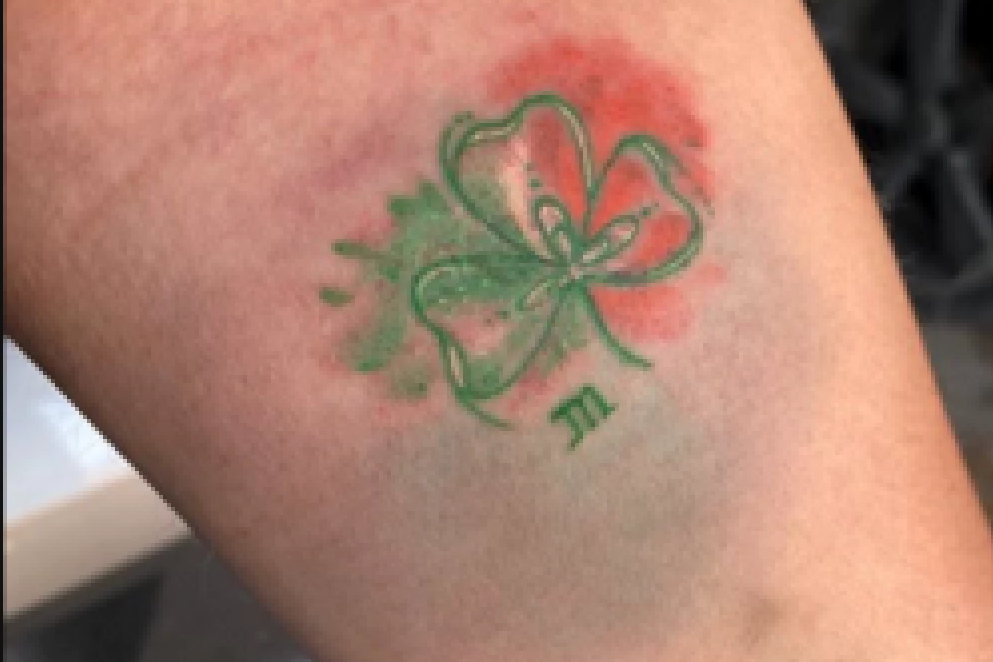Tattooing is a complex art form influenced by various factors, emphasizing the importance of mastery by skilled professionals. Despite experience levels, challenges can arise unexpectedly, presenting hurdles for both seasoned tattoo artists and novices alike. Today, we’ll delve into a dreaded occurrence in the tattooing world: the expanded line effect, commonly referred to as a blowout.
What Exactly is a Blowout?
You have likely encountered tattoos featuring oddly thickened or blurred lines, where the ink seems to spread in unflattering ways. This phenomenon is known as a blowout.
Regrettably, this error is not uncommon and instills fear in those practicing tattooing. Contrary to popular belief, it’s not solely a misstep made by beginners. Even artists with extensive experience can find themselves faced with this issue.
A blowout occurs when the ink surpasses the intended boundaries of the design, resulting in conspicuous blots. Often, this situation arises from the inadequate execution of the tattoo.
When we mention poor execution, we’re not referring to a design flaw or aesthetic displeasure, but rather to flawed techniques employed during the tattooing process. In most instances, the responsibility for blowouts lies with the tattoo artist.
Features of Blowouts
Blowouts often become apparent through a stained area surrounding the tattoo, particularly noticeable in line tattoos where a blurred effect, known as blur, may occur. In more severe instances, blowouts manifest as thick lines with prominent raised areas. Initially, this swelling may be mistaken for typical post-tattoo swelling, but it worsens over time.
It’s essential to understand that blowouts are permanent. While cover-up tattoos or laser removal can somewhat address them, there are limitations to their effectiveness. Once a blowout occurs, there’s limited recourse, highlighting the importance of exercising extreme caution during the tattooing process. Laser treatments are costly and unpleasant, underscoring the need for meticulous attention to the client’s skin and maintaining professional skill.
Blowouts can manifest immediately after tattooing or develop gradually over time. Tattoos may age and expand, becoming blurry or changing color, primarily due to poor injection techniques by the tattoo artist.

It’s worth dispelling the myth that micro-tattoos, particularly micro-realism, expand over time like a blowout. Highly skilled artists have mastered techniques to ensure ink remains fixed, resulting in long-lasting, visually appealing tattoos.
However, it’s important to distinguish between natural ink expansion over time and unwanted expansion due to poor execution during tattooing. Developing a proficient technique takes time and involves understanding various skin types and tattooing at appropriate angles and depths. Training on synthetic skin can aid in honing skills and preventing poorly healed tattoos.
Regardless of skill level, thorough assessment of tattoos after the healing period is crucial. Rushing judgments on newly made tattoos should be avoided, with proper evaluation essential to determine if any aspects need improvement.
Factors that Cause a Blowout
1. Improper needle insertion
Blowouts primarily result from improper needle insertion, whether it’s too shallow or too deep. The skin is comprised of distinct layers: the outermost epidermis, the middle dermis, and the deeper hypodermis containing more fat tissue.
The epidermis acts as a protective shield for the body, comprising cells that continuously regenerate, rendering it dynamic and prone to rapid changes. In contrast, the dermis is a more stable layer with slower regeneration, housing various components like sweat glands, nerve endings, lymphatic vessels, and collagen. Ink injected into the dermis can persist for years, unlike the epidermis, which undergoes more frequent turnover.
Lastly, the hypodermis is primarily composed of fatty tissue, and it’s essential to avoid needle penetration into this layer. Such penetration not only jeopardizes tattoo quality but also poses a risk of significant skin injuries.
2. The client’s skin type
The client’s skin type is another factor to consider during the tattooing procedure. Certain individuals possess highly sensitive skin prone to significant swelling even from minor needle pricks. This sensitivity can impact the final result irrespective of the artist’s skill.
To mitigate this issue, it’s recommended to engage in a discussion with the client beforehand. Gathering information about their skin type and addressing any concerns or inquiries they may have is crucial.
3. The use of low-quality inks.
Surprisingly, the quality of the ink used can also contribute to poor tattoo execution. Some inks lack the necessary consistency and are overly watery, resulting in inadequate adherence to the skin.
There is a common misconception regarding vegetable-based inks, suggesting that they lack highly concentrated pigments. However, this is not true. Both traditional and vegetable-based inks, as long as they are of good quality and approved, should not cause any issues.
Drawbacks in tattooing arise from other factors, not specifically from whether the ink is of vegetable origin or not. It’s important to prioritize using high-quality inks to ensure the best outcomes in tattooing.
4. Carelessness or Accidents of the Clients themselves
There are individuals who, despite being advised against it, engage in activities such as exercising immediately or shortly after getting a tattoo. This behavior can have severe repercussions for the tattoo, as stretching of the skin and exposure to rubbing and impacts increase the risk of ink spreading.
When a freshly tattooed area experiences an impact, there is a heightened risk of ink expansion, potentially leading to a blowout. In such instances, even if the tattoo artist has executed their job with precision, the likelihood of a blowout remains significant.
It’s worth noting that while some clients acknowledge their mistakes and take responsibility for their actions, others may not. They may approach the tattoo artist to complain, incorrectly attributing the blowout to the artist’s error and requesting a fix.
To prevent conflicts, it’s essential to clearly communicate post-tattoo care instructions and emphasize the importance of avoiding exposure to certain activities. If clients fail to adhere to these guidelines, the responsibility does not rest with the artist, as their negligence is beyond the artist’s control.
Are there Risks Associated with Blowouts?
Blowouts themselves generally don’t present direct health hazards. However, there’s a possibility of complications arising during the healing process due to factors like client negligence, which can lead to health risks such as infections.
It’s critical to exercise careful judgment when determining needle depth and voltage levels during tattooing. Applying excessive pressure not only heightens the risk of ink blowouts but also poses a significant danger of injuring the client. Such injuries can have long-lasting consequences.
Therefore, it’s essential to take every necessary precaution to prevent these issues. Always prioritize the well-being of your clients and handle their bodies with the utmost care and reverence, recognizing their sanctity.
RELATED: Flavored Waxing Vs. Normal Waxing: Which is a Better Choice?
